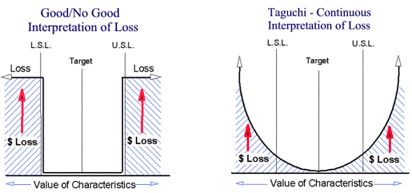Definition
Taguchi methods, or Robust Parameter methods, were developed by the Japanese engineer and Deming prize winner Dr. Genichi Taguchi based on the principle that processes can be made insensitive (robust) to random variation from uncontrollable (noise) Factors by including these Factors in the experimental design.
Taguchi devised large Screening Designs that could test a large number of Factors in a limited number of Experimental Runs. His designs differ from regular Factorial Designs in that they combine two orthogonal designs or ‘arrays', one for the controllable Factors and the other for the noise Factors. The other way in which Taguchi designs diverge from regular factorials is that they combine the mean and variance into a single response variable, the signal-to-noise ratio (SNR). Taguchi’s quality improvement philosophy is founded upon the Quadratic Loss Function which stipulates that the loss to society due to poorly performing products is proportional to the square of the deviation of the performance characteristic from its target value, expressed as
L(y) = k(y-T)2
where T=the target value and k = a constant.
Application
Taguchi's Loss Function:

External Links
Introduction To Robust Design (Taguchi Method) by Madhav S. Phadke from isixsigma.com - http://www.isixsigma.com/library/content/c020311a.asp What are Taguchi Designs? from the NIST Engineering Statistics Handbook: - http://www.itl.nist.gov/div898/handbook/pri/section5/pri56.htm Taguchi Design Tutorial from Statease.com: - http://www.statease.com/e6ug/DE05-Taguchi.pdf
